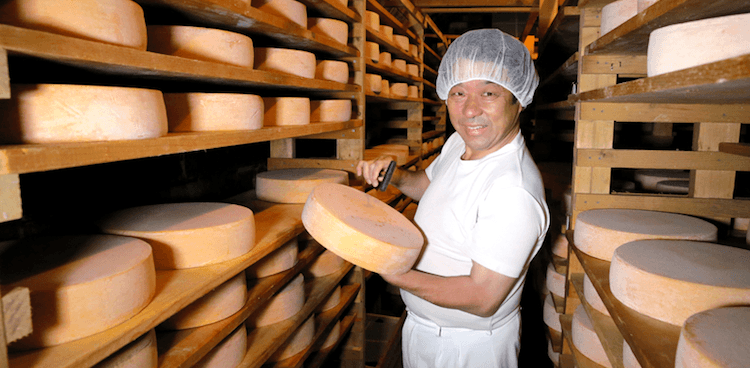
In this blog series, Molly will be (virtually) traveling around the globe to explore the way cheeses are enjoyed and incorporated into different cuisines. Some of these cheeses and methods might seem familiar, while others might be completely new to you. Last week, we talked about China and the country’s lack of cheese culture, as well as some traditional Chinese cheeses. Some of you chimed in on the discussion, and Courtney M. was the winner of our giveaway. This week we learn about Japan and one lucky reader will win a free copy of culture! Get more stamps on your cheese passport and join us for a historical and cultural adventure!
Most of us probably associate Japenese cuisine more with fish than cheese, two foods that many of us avoid pairing with each other. However, the landscape of Japan is actually very well-suited with all the qualities that make good cheese, starting with the grassy, mountainous terrain, with variations in climate throughout the country.
European brands and styles dominate the market for cheese, since “the Japanese palate is most suited to the French styles of cheese,” says culture co-owner and resident cheese expert, Lassa Skinner. “They like the subtler flavors… Nothing too sharp or too strong.” However, domestic cheesemakers have also started crafting their own versions of classics such as camembert-style cheeses.
Cheesemongers provide imported specialty cheeses from around the world at stores like Rumiko Honma’s Fermier, a gourmet shop in Tokyo that sells more than 400 handmade varieties, mostly from Europe. Honma was at the forefront of bringing European cheeses to Japan, opening her shop’s doors in 1986. The demand for these cheeses in rising, with the Japanese consuming more than two kilograms (four and a half pounds) of cheese per person per year as of 2011, though many of the customers at these specialty stores are still foreigners, and these shops are a draw for visitors in the area who want to know where to buy their favorite cheeses.

Rumiko Honma receiving the National Order of Merit from France for her help promoting French cheese in Japan | Photo credit: Image courtesy of the French Embassy in Japan
Some of the early members of the movement towards making artisan cheese, also called “natural handmade” cheese in Japan, were Noriyuki Ikagawa and his wife Akiko. They got into the cheese business after moving to the countryside near Tokyo. Their three Jersey cows didn’t produce much milk, but it was enough to make cheese. The cows live outside year-round and feast on grass as well as rice straw, hay, alfalfa, and turnips. The first Japanese cheese they made was mutschli-style, which is a mild, semi-soft Swiss type of cheese. They named it Satoyama No Cheese.
Japanese-produced cheeses are making waves around the world and gaining recognition in various cheese circles. Shintoku Farm in Hokkaido won the gold medal at the 2004 and 2007 Mountain Cheese Olympics in Switzerland, for their creamy cheese scented with cherry leaves. “Japan’s legendary attention to detail, it seems, is making up for lack of experience in the precise world of cheese,” writes Winifred Bird, in this article for The Japan Times. In 2009, Miyuki Murase and Yuko Inoue won a Silver Trophy for a cheddar-style cheese at the International Caseus Awards in Lyon, France.
The Kyodo Gakusha cooperative is also well-known for its cheeses, having won awards internationally over the past few years. Nozomu Miyajima, president of the company, says, “At the initial stage, we tried to make cheese good enough to compete with the top foreign producers, but we are now at a stage where we can just focus on our original products,” an attitude that reflects many recent trends in Japanese cheesemaking.

Noriyuki and Akiko on their farm | Photo credit: Image courtesy of The Japan Times
Cheeses handcrafted in Japan have also made their way to restaurant menus, most notably at Michelin-starred Signature in Tokyo’s Mandarin Oriental Hotel. The Japan Dairy Council estimates there are around 170 artisanal cheesemakers in the country, and the quality of the cheeses produced have greatly matured in the past few years, making it much easier for a chef to choose Japanese-made cheeses over imported ones for a Tokyo restaurant menu. Many of these options are distinctly Japanese and pay homage to the culture and cuisine of the country. For example, a light herb-scented cheese wrapped in shiso leaves (a kind of Japanese basil), or a bold Hokkaido-made semi-hard cheese that matured while marinating in red miso. Hopefully it’s only a matter of time before those cheeses make their way to our American cheese counters!
Have you tried Japanese cheese? Would you like to? Tell us about it in the comments below for a chance to win a copy of our summer issue! Comments must be posted by 11:59 p.m. EDT on Tuesday, August 26, 2014, to be eligible to win. So comment today and stay tuned for next week’s post, when we travel to Mexico!
Photo Credit: Featured image of Nozomu Miyajima courtesy of The Asahi Shimbun


